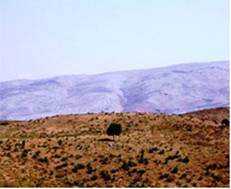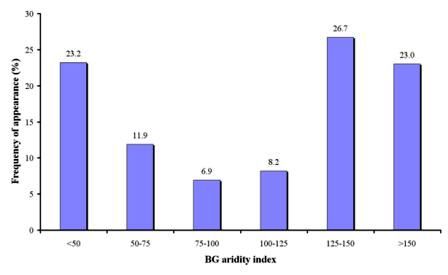Aridity index
The aridity index classifies the type of climate in relation to water availability. The atmospheric conditions that characterize a desert climate are those that create large water deficits, in other words where potential evapotranspiration is much greater than the precipitation. The higher the aridity index of a region the greater the water resources variability and scarcity in time, the more vulnerable the area to desertification (Fig 5a). Soil loss and drought indices can be used to scale the state of health of soil and water resources and consequently to the formulation of strategies compatible with the resources available in a given area.
Aridity index in this study is defined as the ratio between mean annual precipitation (P) and mean annual evapotranspiration (ETo) using the Bagnouls-Gaussen index (BGI) from the following equation:

Where: ti is the mean air temperature for month i in 0°C, Pi is the total precipitation for month i in mm; and k represents the proportion of month during which 2ti - Pi >0.
The following classes have been distinguished for this indicator: (a) BGI<50, (b) BGI ranging from 50-75, (c) BGI ranging from 75-100, (d) BGI ranging from 100-125, (e) BGI ranging from 125=150, and (f) BGI>150.


Fig. 5a Severe drought (1999-2001) affected heavily the olive groves in the plain of Jeffara, Tunisia(left) and grazing land under arid climatic conditions in Crete (right)
Data for this indicator were calculated for 1339 field sites, corresponding to 15 study sites areas (Table 1). The analysis of the data has showed that a great variability in aridity index exists (Fig. 5b). The most important class of aridity index was 125-150, covering 26.7% of the study field sites, and corresponding to the study sites of Guadalentin Basin Murcia-Spain, and Crete-Greece (Fig. 5b). The next important class was the driest (BGI>150), covering 23.3% of the study field sites, corresponding the study sites of Boteti Area-Botswana, Santiago Island-Cape Verde, Zeuss Koutine-Tunisia, Mamora Sehoul-Morocco, and Crete-Greece. The next important The wetter climatic conditions with BGI<50, and 50-75 have been defined in 23.2%, and 11.9% of the study field sites, corresponding to the study sites of Nestos Basin Maggana-Greece, Mação-Portugal, Novij Saratov-Russia, Djanybek-Russia, Secano Interior-Chile, Rendina Basin Basilicata-Italy, Nestos Basin Maggana-Greece, Santiago Island-Cape Verde, Gois-Portugal, Cointzio catchment-Mexico, and Santiago Island-Cape Verde. Intermediate conditions of aridity index (BGI 75-100, 100-125) have been found in 6.9% and 8.2% of the study field sites, corresponding to the study sites of Secano Interior-Chile, Eskisehir-Turkey, and Crete-Greece.

Fig. 5b. Distribution of Bagnouls-Gaussen aridity index classes prevailing in the study field sites